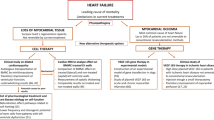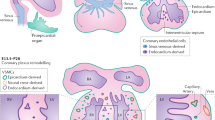Abstract
Clinical trials looking at ways to promote myocardial regeneration have reported that the administered therapies have either neutral effects or modest benefits of questionable impact. These somewhat disappointing results should emphasize the need for translational research, with bidirectional feedback between the basic research laboratory and the clinical arena. Such a translational pathway is illustrated by the quest to find an effective therapy for restenosis, which culminated in the development of sirolimus. At this point a move away from the bedside and a return to the bench seems necessary to better understand the mechanisms of action of progenitor cells and stimulating factors. Without such basic knowledge research might be prematurely discouraged and the opportunity to fully understand the true potential of cardiovascular regenerative therapy might be missed.
Key Points
-
Recent myocardial regeneration trials have reported no or questionable beneficial effects
-
Interpretation of these studies must be cautious owing to the complexity of the factors involved (cell lineages, growth factors, timing of therapy, measured surrogate endpoints, etc.)
-
Lack of meaningful benefits in preliminary studies should not be necessarily considered as a failure of the therapy
-
Extensive work in the basic research laboratory seems now appropriate to elucidate the most adequate targets, and to understand the true mechanisms of action of different types of regenerative therapy
This is a preview of subscription content, access via your institution
Access options
Subscribe to this journal
Receive 12 print issues and online access
$209.00 per year
only $17.42 per issue
Buy this article
- Purchase on Springer Link
- Instant access to full article PDF
Prices may be subject to local taxes which are calculated during checkout



Similar content being viewed by others
References
NHLBI SPARK Working Group [http://www.nhlbi.nih.gov/funding/fromdir/spark2web.htm].
Lefkowitz RJ and Willerson JT (2001) Prospects for cardiovascular research. JAMA 285: 581–587
Smith SC Jr et al. (2001) ACC/AHA guidelines for percutaneous coronary intervention (revision of the 1993 PTCA guidelines)—executive summary: a report of the American College of Cardiology/American Heart Association task force on practice guidelines (Committee to revise the 1993 guidelines for percutaneous transluminal coronary angioplasty); Society for Cardiac Angiography and Interventions. Circulation 103: 3019–3041
Marx SO and Marks AR (2001) Bench to bedside: the development of rapamycin and its application to stent restenosis. Circulation 104: 852–855
Poon M et al. (2002) Overcoming restenosis with sirolimus: from alphabet soup to clinical reality. Lancet 359: 619–622
Gallo R et al. (1999) Inhibition of intimal thickening after balloon angioplasty in porcine coronary arteries by targeting regulators of the cell cycle. Circulation 99: 2164–2170
Worthley SG et al. (2000) Noninvasive in vivo magnetic resonance imaging of experimental coronary artery lesions in a porcine model. Circulation 101: 2956–2961
Babapulle MN et al. (2004) A hierarchical Bayesian meta-analysis of randomised clinical trials of drug-eluting stents. Lancet 364: 583–591
Abizaid A et al. (2001) Clinical and economic impact of diabetes mellitus on percutaneous and surgical treatment of multivessel coronary disease patients: insights from the Arterial Revascularization Therapy Study (ARTS) Trial. Circulation 104: 533–538
Moses JW et al. (2003) Sirolimus-eluting stents versus standard stents in patients with stenosis in a native coronary artery. N Engl J Med 349: 1315–1323
Stone GW et al. (2004) A polymer-based, paclitaxel-eluting stent in patients with coronary artery disease. N Engl J Med 350: 221–231
Mani V et al. (2004) Rapid extended coverage simultaneous multisection black-blood vessel wall MR imaging. Radiology 232: 281–288
Corti R et al. (2002) Lipid lowering by simvastatin induces regression of human atherosclerotic lesions: two years' follow-up by high-resolution noninvasive magnetic resonance imaging. Circulation 106: 2884–2887
Yonemura A et al. (2005) Effect of lipid-lowering therapy with atorvastatin on atherosclerotic aortic plaques detected by noninvasive magnetic resonance imaging. J Am Coll Cardiol 45: 733–742
Corti R et al. (2006) Fenofibrate induces plaque regression in hypercholesterolemic atherosclerotic rabbits: In vivo demonstration by high-resolution MRI. Atherosclerosis [doi:10.1016/j.atherosclerosis.2006.02.036]
Davies JR et al. (2005) Identification of culprit lesions after transient ischemic attack by combined 18F fluorodeoxyglucose positron-emission tomography and high-resolution magnetic resonance imaging. Stroke 36: 2642–2647
Goldschmidt-Clermont PJ et al. (2005) Atherosclerosis 2005: recent discoveries and novel hypotheses. Circulation 112: 3348–3353
Urbich C and Dimmeler S (2004) Endothelial progenitor cells: characterization and role in vascular biology. Circ Res 95: 343–353
Vasa M et al. (2001) Number and migratory activity of circulating endothelial progenitor cells inversely correlate with risk factors for coronary artery disease. Circ Res 89: E1–7
Hill JM et al. (2003) Circulating endothelial progenitor cells, vascular function, and cardiovascular risk. N Engl J Med 348: 593–600
Werner N et al. (2005) Circulating endothelial progenitor cells and cardiovascular outcomes. N Engl J Med 353: 999–1007
Schmidt-Lucke C et al. (2005) Reduced number of circulating endothelial progenitor cells predicts future cardiovascular events: proof of concept for the clinical importance of endogenous vascular repair. Circulation 111: 2981–2987
Kondo T et al. (2004) Smoking cessation rapidly increases circulating progenitor cells in peripheral blood in chronic smokers. Arterioscler Thromb Vasc Biol 24: 1442–1447
Hutter R et al. (2004) Vascular endothelial growth factor regulates reendothelialization and neointima formation in a mouse model of arterial injury. Circulation 110: 2430–2435
Wang C-H et al. (2004) Rosiglitazone facilitates angiogenic progenitor cell differentiation toward endothelial lineage: a new paradigm in glitazone pleiotropy. Circulation 109: 1392–1400
Takamiya M et al. (2006) Granulocyte colony-stimulating factor-mobilized circulating c-Kit+/Flk-1+ progenitor cells regenerate endothelium and inhibit neointimal hyperplasia after vascular injury. Arterioscler Thromb Vasc Biol 26: 751–757
Anversa P et al. (2006) Life and death of cardiac stem cells: a paradigm shift in cardiac biology. Circulation 113: 1451–1463
Cleland JG et al. (2006) Clinical trials update from the American Heart Association: REPAIR-AMI, ASTAMI, JELIS, MEGA, REVIVE-II, SURVIVE, and PROACTIVE. Eur J Heart Fail 8: 105–110
Janssens S et al. (2006) Autologous bone marrow-derived stem cell transfer in patients with ST-segment elevation myocardial infarction: double-blind, randomised controlled trial. Lancet 367: 113–121
Meyer GP et al. (2006) Intracoronary bone marrow cell transfer after myocardial infarction: eighteen months' follow-up data from the randomized, controlled BOOST (BOne marrOw transfer to enhance ST-elevation infarct regeneration) Trial. Circulation 113: 1287–1294
Bartunek J et al. (2005) Intracoronary injection of CD133-positive enriched bone marrow progenitor cells promotes cardiac recovery after recent myocardial infarction: feasibility and safety. Circulation 112 (Suppl 9): I178–183
Chen SL et al. (2004) Effect on left ventricular function of intracoronary transplantation of autologous bone marrow mesenchymal stem cell in patients with acute myocardial infarction. Am J Cardiol 94: 92–95
Kang HJ et al. (2006) Differential effect of intracoronary infusion of mobilized peripheral blood stem cells by granulocyte colony-stimulating factor on left ventricular function and remodeling in patients with acute myocardial infarction versus old myocardial infarction: the MAGIC Cell-3-DES randomized, controlled trial. Circulation 114 (Suppl 1): I145–151
Ince H et al. (2005) Preservation from left ventricular remodeling by front-integrated revascularization and stem cell liberation in evolving acute myocardial infarction by use of granulocyte-colony-stimulating factor (FIRSTLINE-AMI). Circulation 112: 3097–3106
Zohlnhofer D et al. (2006) Stem cell mobilization by granulocyte colony-stimulating factor in patients with acute myocardial infarction: a randomized controlled trial. JAMA 295: 1003–1010
Ripa RS et al. (2006) Stem cell mobilization induced by subcutaneous granulocyte-colony stimulating factor to improve cardiac regeneration after acute ST-elevation myocardial infarction: result of the double-blind, randomized, placebo-controlled stem cells in myocardial infarction (STEMMI) trial. Circulation 113: 1983–1992
Hendrikx M et al. (2006) Recovery of regional but not global contractile function by the direct intramyocardial autologous bone marrow transplantation: results from a randomized controlled clinical trial. Circulation 114 (Suppl 1): I101–107
Erbs S et al. (2005) Transplantation of blood-derived progenitor cells after recanalization of chronic coronary artery occlusion: first randomized and placebo-controlled study. Circ Res 97: 756–762
Smits PC et al. (2003) Catheter-based intramyocardial injection of autologous skeletal myoblasts as a primary treatment of ischemic heart failure: clinical experience with six-month follow-up. J Am Coll Cardiol 42: 2063–2069
Dib N et al. (2005) Safety and feasibility of autologous myoblast transplantation in patients with ischemic cardiomyopathy: four-year follow-up. Circulation 112: 1748–1755
Hagege AA et al. (2006) Skeletal myoblast transplantation in ischemic heart failure: long-term follow-up of the first phase I cohort of patients. Circulation 114 (Suppl 1): I108–113
Iwasaki H et al. (2006) Dose-dependent contribution of CD34-positive cell transplantation to concurrent vasculogenesis and cardiomyogenesis for functional regenerative recovery after myocardial infarction. Circulation 113: 1311–1325
Gruh I et al. (2006) No evidence of transdifferentiation of human endothelial progenitor cells into cardiomyocytes after coculture with neonatal rat cardiomyocytes. Circulation 113: 1326–1334
Menasche P (2006) You can't judge a book by its cover. Circulation 113: 1275–1277
Alexander JH et al. (2005) Efficacy and safety of edifoligide, an E2F transcription factor decoy, for prevention of vein graft failure following coronary artery bypass graft surgery: PREVENT IV: a randomized controlled trial. JAMA 294: 2446–2454
Conte MS et al. (2006) Results of PREVENT III: a multicenter, randomized trial of edifoligide for the prevention of vein graft failure in lower extremity bypass surgery. J Vasc Surg 43: 742–751
Welt FG and Losordo DW (2006) Cell therapy for acute myocardial infarction: curb your enthusiasm? Circulation 113: 1272–1274
Shintani S et al. (2006) Synergistic effect of combined intramyocardial CD34+ cells and VEGF2 gene therapy after MI. Nat Clin Pract Cardiovasc Med 3 (Suppl 1): S123–128
Yoon CH et al. (2005) Synergistic neovascularization by mixed transplantation of early endothelial progenitor cells and late outgrowth endothelial cells: the role of angiogenic cytokines and matrix metalloproteinases. Circulation 112: 1618–1627
Choudhury RP et al. (2004) Molecular, cellular and functional imaging of atherothrombosis. Nat Rev Drug Discov 3: 913–925
Kraitchman DL et al. (2005) Dynamic imaging of allogeneic mesenchymal stem cells trafficking to myocardial infarction. Circulation 112: 1451–1461
Fuster V et al. (2006) The utility of magnetic resonance imaging in cardiac tissue regeneration trials. Nat Clin Pract Cardiovasc Med 3 (Suppl 1): S2–S7
Author information
Authors and Affiliations
Corresponding author
Ethics declarations
Competing interests
The authors declare no competing financial interests.
Rights and permissions
About this article
Cite this article
Fuster, V., Sanz, J. Gene therapy and stem cell therapy for cardiovascular diseases today: a model for translational research. Nat Rev Cardiol 4 (Suppl 1), S1–S8 (2007). https://doi.org/10.1038/ncpcardio0737
Received:
Accepted:
Issue Date:
DOI: https://doi.org/10.1038/ncpcardio0737
This article is cited by
-
Use of arginine–glycine–aspartic acid adhesion peptides coupled with a new collagen scaffold to engineer a myocardium-like tissue graft
Nature Reviews Cardiology (2009)
-
Imaging in cardiac cell-based therapy: in vivo tracking of the biological fate of therapeutic cells
Nature Clinical Practice Cardiovascular Medicine (2008)



